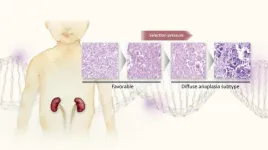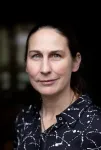(Press-News.org) World Wetlands Day: Bogs hold an important key to the climate crisis
Peat bogs store twice as much CO2 as all of the world's forests combined. A new research center at the University of Copenhagen will map Earth’s wetlands and provide important knowledge about the greenhouse gas budgets of these areas. The Global Wetland Center will teach us how to contain carbon from plants and trees in bogs and other wetlands – and preserve it as well as the ancient bog bodies also found there.
He is world-renowned for coming off as significantly younger than his actual age. A few thousand years younger, more or less. Indeed, those who came across Tollund Man while digging for peat in Bjældskovdal bog in 1950 suspected him to be a recent murder victim.
That was because Tollund Man – like other so-called bog bodies – was found in a wetland. Submerged in the nutrient poor bog, his body was quickly and continuously immersed in an environment free of oxygen, the presence of which is a prerequisite for the decomposition of anything organic – corpses included.
This is precisely what makes wetlands one of the most powerful natural means for us to use to prevent climate change. It is a fact that has gradually dawned upon researchers and decision-makers in recent years – and will be celebrated today, February 2nd, on World Wetlands Day, along with the important role that wetlands play in relation to preserving nature and biodiversity.
Over the next six years, the recently opened Global Wetland Center at the University of Copenhagen’s Department of Geosciences and Natural Resource Management will investigate and map the potential of wetlands and their local variations with the help of a DKK 60 million grant from the Novo Nordisk Foundation. The studies will be conducted in collaboration with the Department of Computer Science (UCPH), GEUS and DHI.
"While local variations need to be investigated, we already know that the conservation of natural wetlands overall provides a significant net gain for the greenhouse gas budget. Under the right conditions, they are able to absorb CO2 and store it beneath shields of water that can indefinitely prevent its decomposition – just like Tollund Man and Grauballe Man. Had they been buried in oxygen-rich locations, we would have never known about them," says Associate Professor Guy Schurgers from the Department of Geosciences and Natural Resource Management, who heads the new center.
Unique CO2 uptake, with a noteworthy exception
Just as in a forest, wetland trees and plants absorb CO2 from the atmosphere. But whereas vegetation on a forest floor decomposes, plants that fall into wetlands become submerged.
"After a number of years, forests end up in an equilibrium due to decomposition, as CO2 absorption and emissions balance to zero. Wetlands do not. Due to the water's ability to shut off oxygen from the atmosphere, the areas are unique in their ability to continue pulling CO2 from the atmosphere," explains Guy Schurgers.
This also means that wetlands store many years’ worth of carbon removal. For example, while peat bogs make up only about 3% of the Earth's landmass, they store twice as much carbon as all of the world's forests combined.
However, there is a negative in the budget that demands further examination: methane and nitrous oxide.
"Globally, we know that, as a whole, these areas are the most efficient way to extract CO2 from the atmosphere and maintain it naturally. However, one also finds local wetlands where the greenhouse gas budget is negative. This is partly because, due to the lack of oxygen, wetlands have a negative by-product in the form of methane production. Even though it is produced in small quantities, methane is a potent greenhouse gas and it is important that we investigate this mechanism in depth," he says.
In nitrogen-rich areas, oxygen-poor conditions can also contribute to the production of nitrous oxide – another important greenhouse gas. This can occur in fertilised rice paddies or wetlands which receive nitrogen from nearby farms.
As such, one of the center's main tasks will be to gather local knowledge about wetlands around the world.
Experiments must find local differences and solutions
Wetlands are far from uniform. Because of their diversity, Guy Schurgers explains that it is essential for the Global Wetland Center to develop models for studying the phenomenon. These models need to be able to account for local differences – such as the role of water tables in the tropics versus the tundra and on the coast or inland – as well as being able to detect commonalities across the differences.
"Once the models can distinguish correctly, we hope they’ll be able to be used to map the global extent of wetlands and give us a better idea of exactly what these areas mean for our planet's climate with the help of satellite imagery. Today’s increased resolutions offer opportunities that didn’t exist five years ago," says Guy Schurgers.
But to make doing so possible, studying wetlands from above is insufficient – scientists will need to get their feet on the ground. Because in many places, their understanding of wetlands is very limited. This is particularly true for the less well-studied wetlands beyond Europe and North America.
As such, the center will conduct case studies with actual experiments in wetlands, initially in Vietnam, Tanzania and Norway.
An important aspect of the center's agenda is for the results to not end up stranded on a university shelf, but for them to be useful and rapidly passed along to decision-makers. This is also one of the reasons why the project focuses on case-study experiments.
"Field studies will allow us to obtain experiment results that are ready to be applied in practice. Therefore, we will also be certain to incorporate local considerations into the design, so that our discoveries can actually be used by agencies and not end up as theoretical exercises," concludes the researcher.
*
Facts: What is a wetland?
There are many types of wetlands around the world. The term encompasses wet areas where water is located either just above or below the soil surface.
There are both fresh and saltwater wetlands. In Denmark, the best examples are bogs and marshes, but mangrove forests and tropical swamps are also examples of wetlands.
Major differences exist between wetlands. For example, in Vietnam, researchers expect to find wetlands that emit more greenhouse gases than they absorb – specifically in connection with rice paddies.
Facts: Experiments in three countries
The researchers will conduct experiments in various wetlands in Vietnam, Tanzania and Norway so as to investigate local differences with a major focus on two types of consequences:
How do wetlands – and changes in their environmental conditions – affect the greenhouse gas budget for the emissions and removal of carbon dioxide (CO2), methane (CH4) and nitrous oxide (N2O)?
What are the consequences for populations in each area? For example, how does the status quo or a particular management solution impact harvests?
Facts: Global Wetland Center
The Global Wetland Center officially opened at the beginning of the year and its work has long since begun.
Keep up with the center's activities on their website: www.globalwetlandcenter.ku.dk
In conjunction with World Wetlands Day, an opening celebration with presentations about the center's activities will be held on Friday 2/2 at 2pm. The event is open to all and may be registered for by writing to Center Administrator Tania Nielsen at tn@ign.ku.dk.
Extra info: An interdisciplinary dream team
The center, which opened 1 January, gathers professionals from diverse backgrounds who haven't worked together on the same scale before. Guy Schurgers describes the center's assembly of geographers, computer scientists and engineers as an interdisciplinary "dream team" that will take research to new levels.
Experimenters will study the biogeochemical mechanisms of the exchange of carbon as greenhouse gases (CO2, CH4, N2O) and the different ways they play out in various types of wetlands.
Modelers will translate this knowledge into biogeochemical and hydrological models that can be used to understand the mechanisms on a larger scale.
Using satellite images, Earth Observation specialists will provide knowledge about the extent of and changes to wetlands over time.
Computer scientists from UCPH’s Department of Computer Science (DIKU) will use AI tools to extend the analyses and models up to a global scale.
Skilled practitioners must develop implementable methods to improve wetlands and make the new knowledge understandable and usable for decision-makers.
As collaborative partners with the Global Wetland Center, GEUS, contributing with hydrological field and modelling expertise, and DHI, contributing with expertise on Earth observation and modelling and as Danish link to the UN's environmental organization, UNEP, participate in the project. END
World Wetlands Day: Bogs hold an important key to the climate crisis
Peat bogs store twice as much CO2 as all of the world's forests combined. A new research center at the University of Copenhagen will map Earth’s wetlands and provide important knowledge about the greenhouse gas budgets of these areas.
2024-02-02
ELSE PRESS RELEASES FROM THIS DATE:
Natural therapy shows promise for dry-eye disease
2024-02-02
Researchers at the University of Auckland are running a trial of castor oil as a potential safe and natural treatment for dry-eye disease following a successful pilot study.
While exact figures aren’t available for New Zealand, in Australia, it is estimated dry-eye disease affects around 58 percent of the population aged over 50.
Advancing age, menopause, increased screen time, contact lens wear are just some of the risk factors for developing dry eye disease.
Blepharitis is the most common cause of dry-eye disease, accounting for more than 80 percent of cases. It is a chronic condition with no known cure.
“Currently, patients ...
Researchers study role of post-transcriptional splicing in plant response to light
2024-02-02
In a study recently published in the PNAS on Jan. 30, a research team led by Prof. CAO Xiaofeng from the Institute of Genetics and Developmental Biology of the Chinese Academy of Sciences, in collaboration with researchers from the Southern University of Science and Technology, reported a new understanding of how light affects plant growth.
Light plays a central role in plant growth and development, providing an energy source and governing various aspects of plant morphology. Post-transcriptional splicing (PTS) has been previously discovered to generate polyadenylated full-length transcripts. These transcripts, ...
Gene-editing offers hope for people with hereditary disorder
2024-02-02
A group of patients with a hereditary disorder have had their lives transformed by a single treatment of a breakthrough gene-editing therapy, according to the lead researcher.
The patients from New Zealand, the Netherlands and the UK have hereditary angioedema, a genetic disorder characterised by severe, painful and unpredictable swelling attacks. These interfere with daily life and can affect airways and prove fatal.
Now researchers from the University of Auckland, Amsterdam University Medical Center and Cambridge University Hospitals have successfully treated more than ten patients with the CRISPR/Cas9 therapy, ...
New molecule from University step closer to treatment for rare disease
2024-02-02
A molecule created at the University of Auckland is one step closer to becoming a treatment for an extremely rare and severely debilitating neurological disorder called Phelan-McDermid syndrome. Children with the disorder showed significant improvements in a phase two clinical trial in the US, Neuren Pharmaceuticals, which is listed on the Australian Securities Exchange, said in December.
Next steps would be a phase three trial and seeking approval from the US Food & Drug Administration. The molecule, NNZ-2591, comes from work years ago ...
Machine learning to battle COVID-19 bacterial co-infection
2024-02-02
University of Queensland researchers have used machine learning to help predict the risk of secondary bacterial infections in hospitalised COVID-19 patients.
The machine learning technique can help detect whether antibiotic use is critical for patients with these infections.
Associate Professor Kirsty Short from the School of Chemistry and Molecular Biosciences said secondary bacterial infections can be extremely dangerous for those hospitalised with COVID-19.
“Estimates of the incidents of secondary bacterial infections in COVID-19 ...
Some tumors ‘grow bad’: Why a dangerous subtype of Wilms tumor is so resistant to chemotherapy
2024-02-02
An international team, led by researchers at Nagoya University in Japan, may have determined why the diffuse anaplasia (DA) subtype of Wilms tumor (WT) resists chemotherapy. This subtype grows even when it has a high burden of DNA damage and increases the mutation rate of tumor protein 53 (TP53), a gene that plays a critical role in the regulation of cell growth and division. The team’s findings, published in Modern Pathology, suggest new ways to treat this subtype.
WT, also known as nephroblastoma, is the most common childhood cancer originating in the kidney. Fortunately, the survival rate of adolescents ...
Disrupted cellular function behind type 2 diabetes in obesity
2024-02-02
Disrupted function of “cleaning cells” in the body may help to explain why some people with obesity develop type 2 diabetes, while others do not. A study from the University of Gothenburg describes this newly discovered mechanism.
It is well known that obesity increases the risk of insulin resistance and type 2 diabetes. It is also well known that some people who gain weight suffer from the disease and others do not. The reasons for these differences are not clear, but they are related ...
USC launches School of Advanced Computing
2024-02-02
USC President Carol Folt launched the university’s first new school in more than a decade: the USC School of Advanced Computing, a cornerstone of her $1 billion advanced computing initiative. The school seeks to educate all students, regardless of their major, in the ethical use of computing technology as part of the president’s Frontiers of Computing initiative.
Gaurav Sukhatme — a professor of computer science and electrical and computer engineering, and executive vice dean of the USC Viterbi School of ...
A clutch stretch goes a long way
2024-02-02
Kyoto, Japan -- Cell biology has possibly never jumped to the next level in the same way.
In multicellular organisms, cell migration and mechanosensing are essential for cellular development and maintenance. These processes rely on talin, the key focal adhesion -- or FA -- protein, central in connecting adjacent cellular matrices and enabling force transmission between them.
Talins are commonly considered fully extended at FAs between actin filaments -- or F-actin -- and the anchor-like integrin receptor.
Yet, a research ...
Psychological care delivered over the phone is an effective way to combat loneliness and depression, according to a major new study
2024-02-02
The study, led by a team based at the University of York and Hull York Medical School and at Tees, Esk and Wear Valleys NHS Foundation Trust, found levels of depression reduced significantly and the benefits were greater than those seen for antidepressants.
Participants in the study reported their levels of emotional loneliness fell by 21% over a three-month period and the benefits remained after the phone calls had ceased, suggesting an enduring impact.
The Behavioural Activation in Social ...
LAST 30 PRESS RELEASES:
Study showcases resilience and rapid growth of “living rocks”
Naval Research Lab diver earns Office of Naval Research 2025 Sailor of the Year
New Mayo-led study establishes practical definition for rapidly progressive dementia
Fossil fuel industry’s “climate false solutions” reinforce its power and aggravate environmental injustice
Researchers reveal bias in a widely used measure of algorithm performance
Alcohol causes cancer. A study from IOCB Prague confirms damage to DNA and shows how cells defend against it
Hidden viruses in wastewater treatment may shape public health risks, study finds
Unlock the power of nature: how biomass can transform climate mitigation
Biochar reshapes hidden soil microbes that capture carbon dioxide in farmland
Reducing saturated fat intake shows mortality benefit, but only in high-risk individuals
Manta rays create mobile ecosystems, study finds
Study: Mixed results in using lipoic acid to treat progressive multiple sclerosis
Norbert Holtkamp appointed director of Fermi National Accelerator Laboratory
New agentic AI platform accelerates advanced optics design
Biologists discover neurons use physical signals — not electricity — to stabilize communication
Researchers discover that a hormone can access the brain by hitchhiking
University of Oklahoma researcher awarded funding to pursue AI-powered material design
Exploring how the visual system recovers following injury
Support for parents with infants at pediatric check-ups leads to better reading and math skills in elementary school
Kids’ behavioral health is a growing share of family health costs
Day & night: Cancer disrupts the brain’s natural rhythm
COVID-19 vaccination significantly reduces risk to pregnant women and baby
The role of vaccination in maternal and perinatal outcomes associated with COVID-19 in pregnancy
Mayo Clinic smartwatch system helps parents shorten and defuse children's severe tantrums early
Behavioral health spending spikes to 40% of all children’s health expenditures, nearly doubling in a decade
Digital cognitive behavioral treatment for generalized anxiety disorder
Expenditures for pediatric behavioral health care over time and estimated family financial burden
Air conditioning in nursing homes and mortality during extreme heat
The Alps to lose a record number of glaciers in the next decade
What makes a good proton conductor?
[Press-News.org] World Wetlands Day: Bogs hold an important key to the climate crisisPeat bogs store twice as much CO2 as all of the world's forests combined. A new research center at the University of Copenhagen will map Earth’s wetlands and provide important knowledge about the greenhouse gas budgets of these areas.



